(完整版)人教版七年级英语上册知识点整理
- 格式:docx
- 大小:77.09 KB
- 文档页数:13
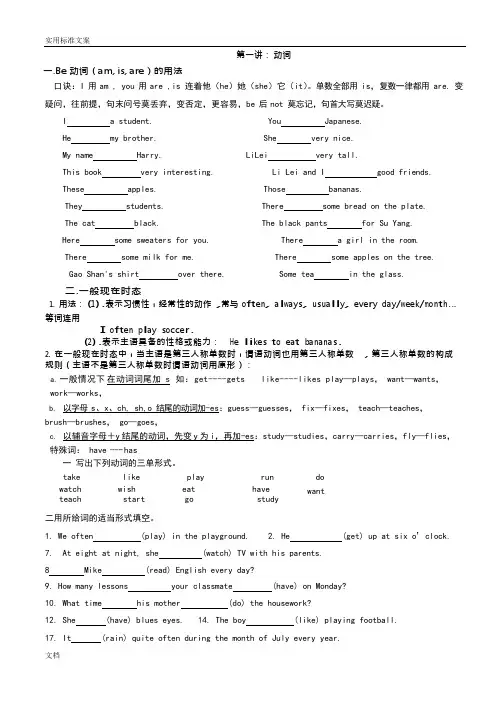
第一讲:动词一.Be 动词(am, is, are)的用法口诀:I 用 am , you 用 are ,is 连着他(he)她(she)它(it)。
单数全部用 is,复数一律都用 are. 变疑问,往前提,句末问号莫丢弃,变否定,更容易,be 后 not 莫忘记,句首大写莫迟疑。
I a student. You Japanese.He my brother. She very nice.My name Harry. LiLei very tall.This book very interesting. Li Lei and I good friends.These apples. Those bananas.They students. There some bread on the plate.The cat black. The black pants for Su Yang.Here some sweaters for you. There a girl in the room.There some milk for me. There some apples on the tree.Gao Shan's shirt over there. Some tea in the glass.二.一般现在时态1.用法:(1).表示习惯性,经常性的动作,常与o f t e n,a l w a y s,u s u a ll y,e v e r y d a y/w ee k/m o n t h…等词连用I o f t e n p l a y s o cc e r.(2).表示主语具备的性格或能力:H e li k e s t o e a t b a n a n a s.2.在一般现在时态中,当主语是第三人称单数时,谓语动词也用第三人称单数, 第三人称单数的构成规则(主语不是第三人称单数时谓语动词用原形):a.一般情况下在动词词尾加 s 如:get----gets like----likes play—plays, want—wants,work—works,b.以字母 s、x、ch, sh,o 结尾的动词加-es:guess—guesses, fix—fixes, teach—teaches,brush—brushes, go—goes,c.以辅音字母+y 结尾的动词,先变y 为i,再加-es:study—studies,carry—carries,fly—flies,特殊词: have --- has一写出下列动词的三单形式。
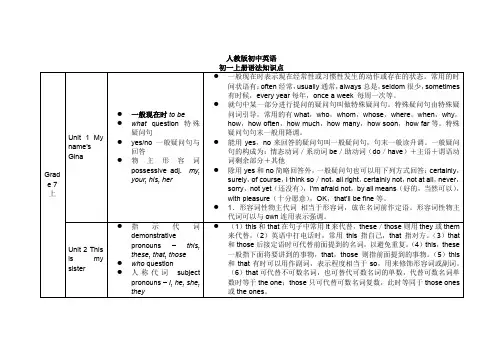
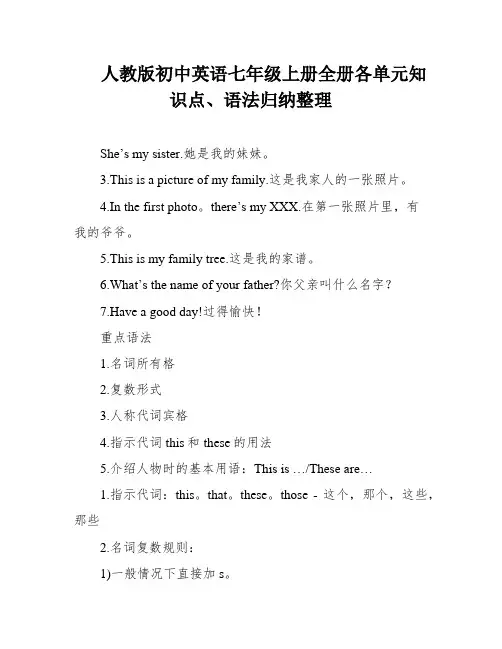
人教版初中英语七年级上册全册各单元知识点、语法归纳整理She’s my sister.她是我的妹妹。
3.This is a picture of my family.这是我家人的一张照片。
4.In the first photo。
there’s my XXX.在第一张照片里,有我的爷爷。
5.This is my family tree.这是我的家谱。
6.What’s the name of your father?你父亲叫什么名字?7.Have a good day!过得愉快!重点语法1.名词所有格2.复数形式3.人称代词宾格4.指示代词this和these的用法5.介绍人物时的基本用语:This is …/These are…1.指示代词:this。
that。
these。
those - 这个,那个,这些,那些2.名词复数规则:1)一般情况下直接加s。
2)以s,x,sh,ch结尾的加es。
3)以辅音字母加y结尾的将y变i再加es。
4)以o结尾的加s或es。
(有生命+es物生命加s)5)以f/fe结尾的名词,先将f/fv变成v再加es。
3.人称代词:I。
he。
she。
it和they - 我,他,她,它,他们/她们/它们4.重点短语:Is this/that your。
- 这/那是你的……吗?Yes。
it is。
/ No。
it isn't。
- 是的,是它。
/ 不,不是。
XXX。
- 这些/那些是我的……Here are。
- 这里有……This/That is my。
- 这/那是我的……Have a good day。
- 祝你玩得愉快!Excuse me for interrupting。
but could I ask you a n?Thank you very much.Could you please speak in English?Do you enjoy playing computer games?Have you checked in the lost and found case to see if your item is there?Please call 685-6034 to reach me.I lost my school ID card and need to find it.I need a set of pencils for my art class.Key XXX structures:Is that your school bag?No。
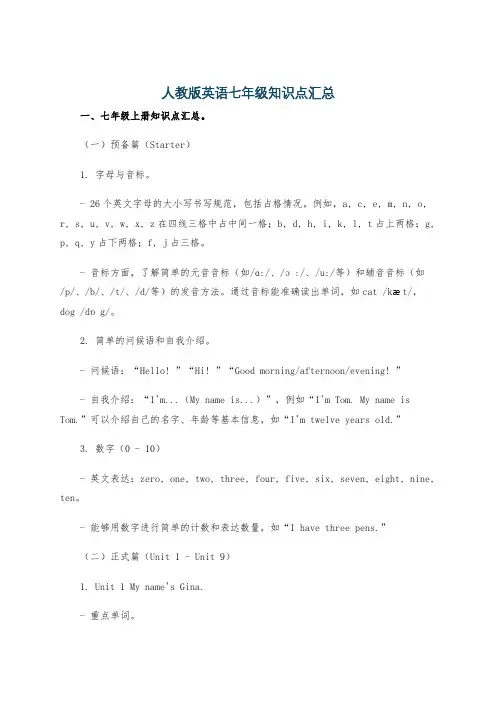
人教版英语七年级知识点汇总一、七年级上册知识点汇总。
(一)预备篇(Starter)1. 字母与音标。
- 26个英文字母的大小写书写规范,包括占格情况。
例如,a, c, e, m, n, o, r, s, u, v, w, x, z在四线三格中占中间一格;b, d, h, i, k, l, t占上两格;g, p, q, y占下两格;f, j占三格。
- 音标方面,了解简单的元音音标(如/ɑ:/、/ɔ:/、/u:/等)和辅音音标(如/p/、/b/、/t/、/d/等)的发音方法。
通过音标能准确读出单词,如cat /kæt/,dog /dɒg/。
2. 简单的问候语和自我介绍。
- 问候语:“Hello! ”“Hi! ”“Good morning/afternoon/evening! ”- 自我介绍:“I'm...(My name is...)”,例如“I'm Tom. My name is Tom.”可以介绍自己的名字、年龄等基本信息,如“I'm twelve years old.”3. 数字(0 - 10)- 英文表达:zero, one, two, three, four, five, six, seven, eight, nine, ten。
- 能够用数字进行简单的计数和表达数量,如“I have three pens.”(二)正式篇(Unit 1 - Unit 9)1. Unit 1 My name's Gina.- 重点单词。
- name(名字),nice(美好的),to(不定式符号,无实义),meet(遇见),too(也),your(你的;你们的),his(他的),her(她的)。
- 重点句型。
- “What's your name? ”“My name's...(I'm...)”用于询问和回答名字。
- “Nice to meet you. ”“Nice to meet you, too.”用于初次见面时的问候。
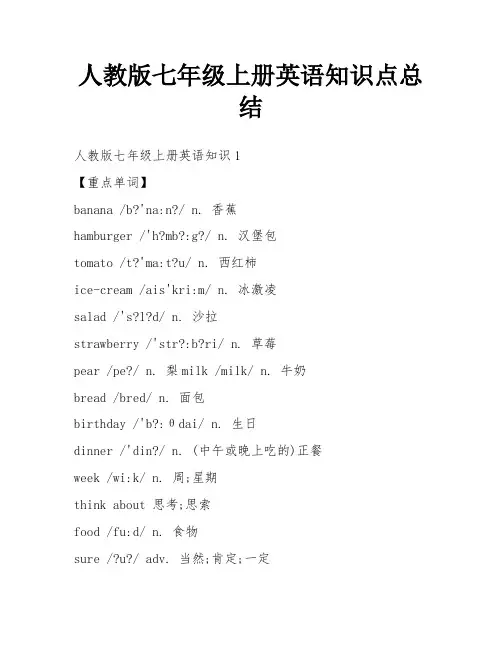
人教版七年级上册英语知识点总结人教版七年级上册英语知识1【重点单词】banana /b?'na:n?/ n. 香蕉hamburger /'h?mb?:g?/ n. 汉堡包tomato /t?'ma:t?u/ n. 西红柿ice-cream /ais'kri:m/ n. 冰激凌salad /'s?l?d/ n. 沙拉strawberry /'str?:b?ri/ n. 草莓pear /pe?/ n. 梨milk /milk/ n. 牛奶bread /bred/ n. 面包birthday /'b?:θdai/ n. 生日dinner /'din?/ n. (中午或晚上吃的)正餐week /wi:k/ n. 周;星期think about 思考;思索food /fu:d/ n. 食物sure /?u?/ adv. 当然;肯定;一定How about...? (提出建议)......怎么样? burger /'b?:g?/ n. (=hamburger)汉堡包vegetable /'ved?t?bl/ n. 蔬菜fruit /fru:t/ n. 水果right /rait/ adj. 正确的;适当的apple /'?pl/ n. 苹果then /?en/ adv. 那么egg /eg/ n. 蛋;鸡蛋carrot /'k?r?t/ n. 胡萝卜rice /rais/ n. 大米;米饭chicken /'t?ikin/ n. 鸡肉so /s?u/ conj. (引出评论或问题)那么breakfast /'brekf?st/ n. 早餐;早饭lunch /l?nt?/ n. 午餐star /sta:/ n. 明星;星星eat /i:t/ v. 吃well /wel/ adv. 好;令人满意地habit /'h?bit/ n. 习惯healthy /'helθi/ adj. 健康的really /'ri:?li/ adv. 真正地question /'kwest??n/ n. 问题want /w?nt/ v. 需要;想要be /bi:/ v. 变成fat /f?t/ adj. 肥的;肥胖的一.短语归纳1.John’s birthdaydinner 约翰的生日晚餐2.next week 下周3.think about 思考、考虑4.how about 怎么样5.some fruit 一些水果6.his birthday 他的生日7.sport star 体育明星 8.eating habits 饮食习惯9.for breakfast 作为早餐 10.for dinner 作为晚餐11.one lastquestion 最后一个问题 12.healthy food 健康的食品二.重点句型:1.have sth 吃……2.—Do you like…? 你喜欢…吗?—Yes, I do / No, I don’t. 是的,我喜欢/不,我不喜欢。
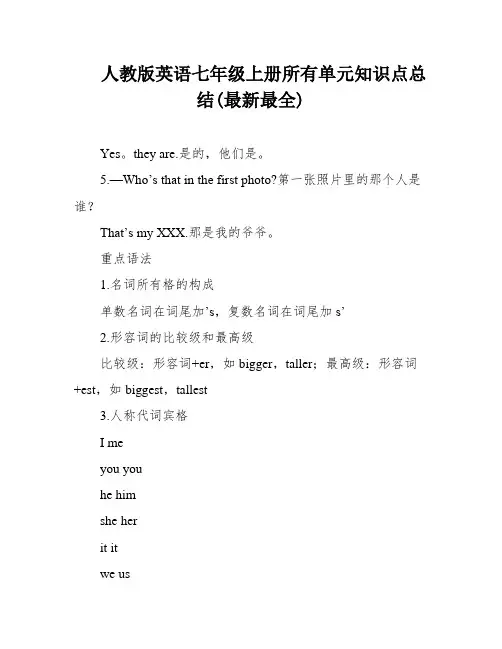
人教版英语七年级上册所有单元知识点总结(最新最全)Yes。
they are.是的,他们是。
5.—Who’s that in the first photo?第一张照片里的那个人是谁?That’s my XXX.那是我的爷爷。
重点语法1.名词所有格的构成单数名词在词尾加’s,复数名词在词尾加s’2.形容词的比较级和最高级比较级:形容词+er,如bigger,taller;最高级:形容词+est,如biggest,tallest3.人称代词宾格I meyou youhe himshe herit itwe usthey themUnit3 Is this your pencil?重点短语1.school bag书包2.XXX在学校3.in the pencil box在铅笔盒里4.the blue one那个蓝色的5.on XXX在桌子上XXX在书包里重点句型1.—Is this your pencil?这是你的铅笔吗?Yes。
it is./No。
it isn’t.是的/不是。
2.—What color is your pencil case?你的铅笔盒是什么颜色的?It’s blue.它是蓝色的。
3.This XXX.这是我的书包。
4.—What’s in your pencil box?你的铅笔盒里有什么?Some pencils。
XXX.一些铅笔、一支钢笔和一个橡皮。
5.—Where’s my ruler?我的尺子在哪里?It’s on the desk.它在桌子上。
重点语法1.物主代词的宾格my meyour youhis himher herits itour ustheir them2.名词的单复数形式一般情况下,在名词后加s表示复数,如pencils,desks;不规则变化的名词需要记忆,如child-children,mouse-mice等。
3.介词in和on的用法in表示在某个范围或物体内部,如in the pencil box,在铅笔盒里;on表示在某个物体表面或位置上,如on the desk,在桌子上。
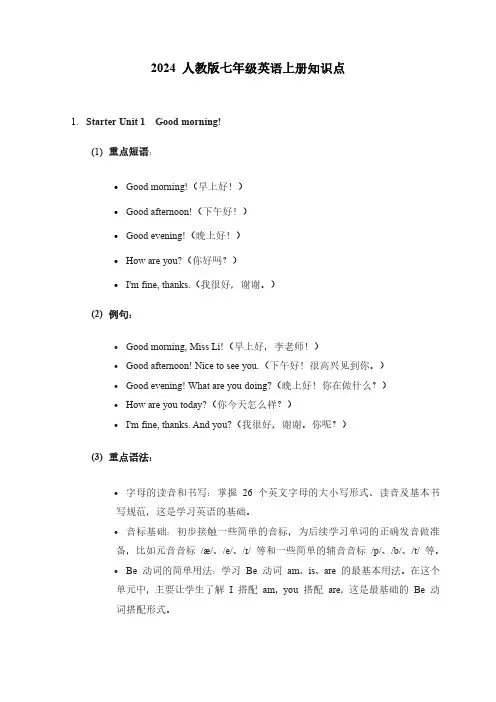
2024人教版七年级英语上册知识点1.Starter Unit1Good morning!(1)重点短语:∙Good morning!(早上好!)∙Good afternoon!(下午好!)∙Good evening!(晚上好!)∙How are you?(你好吗?)∙I'm fine,thanks.(我很好,谢谢。
)(2)例句:∙Good morning,Miss Li!(早上好,李老师!)∙Good afternoon!Nice to see you.(下午好!很高兴见到你。
)∙Good evening!What are you doing?(晚上好!你在做什么?)∙How are you today?(你今天怎么样?)∙I'm fine,thanks.And you?(我很好,谢谢。
你呢?)(3)重点语法:∙字母的读音和书写:掌握26个英文字母的大小写形式、读音及基本书写规范,这是学习英语的基础。
∙音标基础:初步接触一些简单的音标,为后续学习单词的正确发音做准备,比如元音音标/æ/、/e/、/ɪ/等和一些简单的辅音音标/p/、/b/、/t/等。
∙Be动词的简单用法:学习Be动词am、is、are的最基本用法。
在这个单元中,主要让学生了解I搭配am,you搭配are,这是最基础的Be动词搭配形式。
2.Starter Unit2What's this in English?:(1)重点单词:map(地图)cup(杯子)ruler(尺子)pen(钢笔)orange(橙子)jacket(夹克衫)key(钥匙)quilt(被子)what(什么)in(在……里)English(英语;英文)。
(2)重点短语:∙询问物品:What's this in English?(这个用英语怎么说?)、What's that inEnglish?(那个用英语怎么说?)∙回答方式:It's a/an...(它是一个……)。
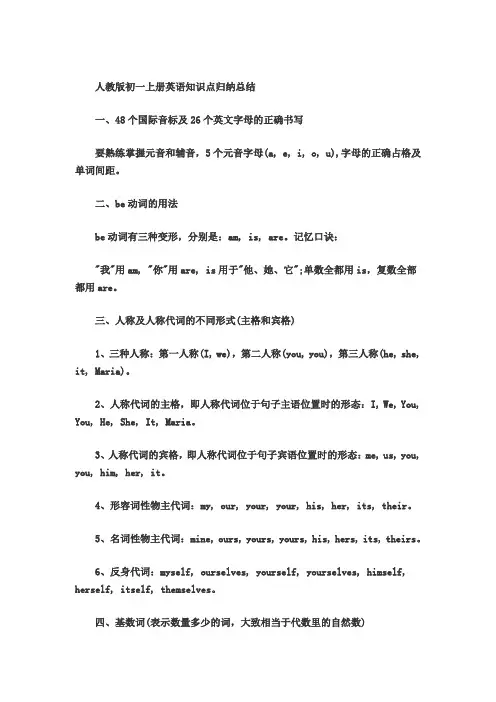
人教版初一上册英语知识点归纳总结一、48个国际音标及26个英文字母的正确书写要熟练掌握元音和辅音,5个元音字母(a, e, i, o, u),字母的正确占格及单词间距。
二、be动词的用法be动词有三种变形,分别是:am, is, are。
记忆口诀:"我"用am, "你"用are, is用于"他、她、它";单数全都用is,复数全部都用are。
三、人称及人称代词的不同形式(主格和宾格)1、三种人称:第一人称(I, we),第二人称(you, you),第三人称(he, she, it, Maria)。
2、人称代词的主格,即人称代词位于句子主语位置时的形态:I, We, You, You, He, She, It, Maria。
3、人称代词的宾格,即人称代词位于句子宾语位置时的形态:me, us, you, you, him, her, it。
4、形容词性物主代词:my, our, your, your, his, her, its, their。
5、名词性物主代词:mine, ours, yours, yours, his, hers, its, theirs。
6、反身代词:myself, ourselves, yourself, yourselves, himself, herself, itself, themselves。
四、基数词(表示数量多少的词,大致相当于代数里的自然数)zero, one, two, three, four, five, six, seven, eight, nine, ten, eleven, twelve, thirteen, fourteen, fifteen, sixteen, seventeen, eighteen, nineteen, twenty, twenty-one, twenty-two,twenty-three,twenty-four, twenty-five, twenty-six, twenty-seven, twenty-eight, twenty-nine, thirty, forty, fifty, sixty,seventy, eighty, ninety, one hundred,one hundred and one。
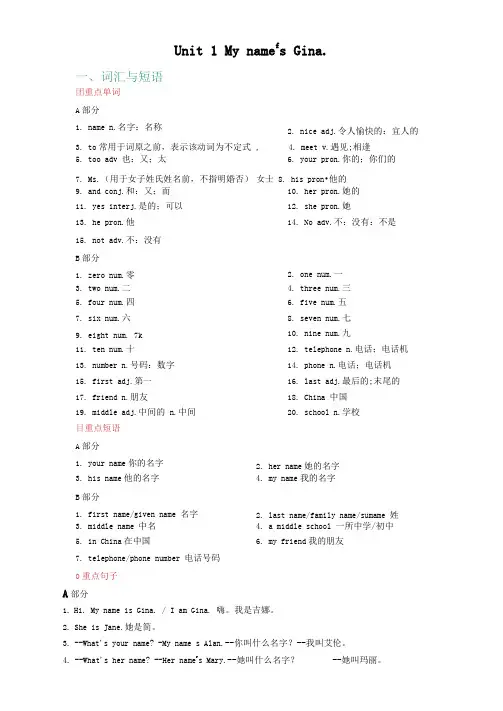
Unit 1 My name f s Gina.一、词汇与短语团重点单词A部分1. name n.名字:名称2. nice adj.令人愉快的:宜人的3. to常用于词原之前,表示该动词为不定式,4. meet v.遇见;相逢5. too adv 也:又;太6. your pron.你的;你们的7. Ms.(用于女子姓氏姓名前,不指明婚否)女士8. his pron•他的9. and conj.和:又;而10. her pron.她的11. yes interj.是的;可以12. she pron.她13. he pron.他14. No adv.不:没有:不是15. not adv.不:没有B部分1. zero num.零2. one num.一3. two num.二4. three num.三5. four num.四6. five num.五7. six num.六8. seven num.七9. eight num. 7k 10. nine num.九11. ten num.十12. telephone n.电话;电话机13. number n.号码:数字14. phone n.电话;电话机15. first adj.第一16. last adj.最后的;末尾的17. friend n.朋友18. China 中国19. middle adj.中间的n.中间20. school n.学校目重点短语A部分1. your name你的名字2. her name她的名字3. his name他的名字4. my name我的名字B部分1. first name/given name 名字2. last name/family name/sumame 姓3. middle name 中名4. a middle school 一所中学/初中5. in China在中国6. my friend我的朋友7. telephone/phone number 电话号码0重点句子A部分1.Hi. My name is Gina. / I am Gina. 嗨。
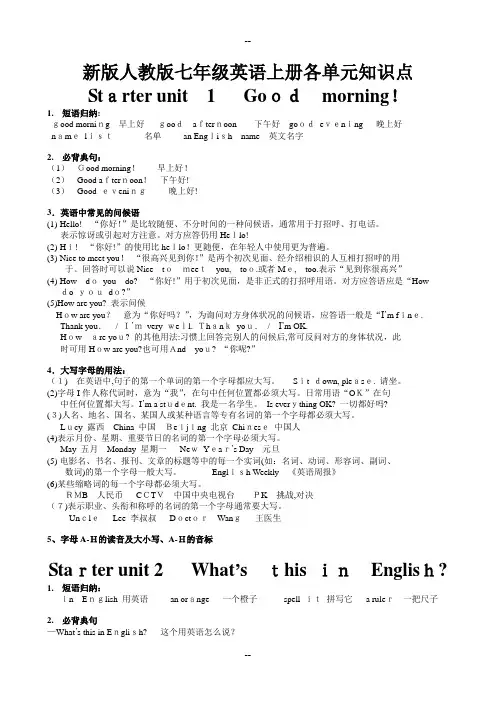
新版人教版七年级英语上册各单元知识点Starter unit 1 Goodmorning!1.短语归纳:good morning 早上好goodafternoon下午好goodevening 晚上好namelist名单an English name 英文名字2.必背典句:(1)Good morning!早上好!(2)Good afternoon!下午好!(3)Good evening晚上好!3.英语中常见的问候语(1)Hello!“你好!”是比较随便、不分时间的一种问候语,通常用于打招呼、打电话。
表示惊讶或引起对方注意。
对方应答仍用Hello!(2)Hi!“你好!”的使用比hello!更随便,在年轻人中使用更为普遍。
(3)Nice to meet you!“很高兴见到你!”是两个初次见面、经介绍相识的人互相打招呼的用于。
回答时可以说Nice tomeetyou,too.或者Me,too.表示“见到你很高兴”(4)How doyou do?“你好!”用于初次见面,是非正式的打招呼用语。
对方应答语应是“Howdo youdo?”(5)How are you? 表示问候How are you?意为“你好吗?”,为询问对方身体状况的问候语,应答语一般是“I’m fine.Thank you./ I’mvery well. Thankyou./I’m OK.Howare you? 的其他用法:习惯上回答完别人的问候后,常可反问对方的身体状况,此时可用How are you?也可用And you? “你呢?”4.大写字母的用法:(1)在英语中,句子的第一个单词的第一个字母都应大写。
Sit down, please. 请坐。
(2)字母I作人称代词时,意为“我”,在句中任何位置都必须大写。
日常用语“OK”在句中任何位置都大写。
I’m a student. 我是一名学生。
Is everything OK? 一切都好吗?(3)人名、地名、国名、某国人或某种语言等专有名词的第一个字母都必须大写。
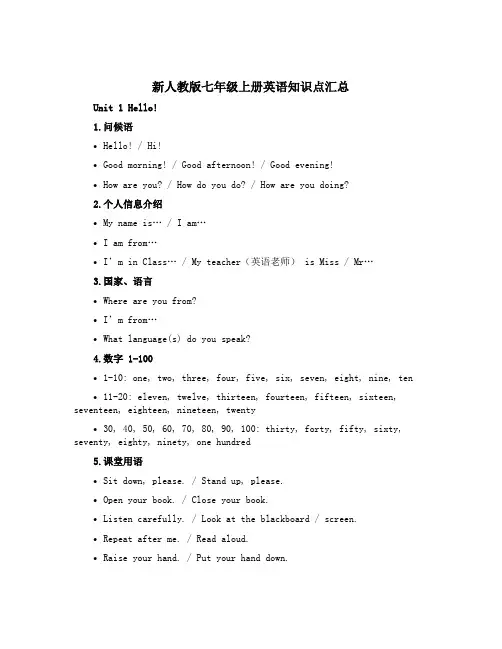
新人教版七年级上册英语知识点汇总Unit 1 Hello!1.问候语•Hello! / Hi!•Good morning! / Good afternoon! / Good evening!•How are you? / How do you do? / How are you doing?2.个人信息介绍•My name is… / I am…•I am from…•I’m in Class… / My teacher(英语老师)is Miss / Mr…3.国家、语言•Where are you from?•I’m from…•What language(s) do you speak?4.数字 1-100•1-10: one, two, three, four, five, six, seven, eight, nine, ten •11-20: eleven, twelve, thirteen, fourteen, fifteen, sixteen, seventeen, eighteen, nineteen, twenty•30, 40, 50, 60, 70, 80, 90, 100: thirty, forty, fifty, sixty, seventy, eighty, ninety, one hundred5.课堂用语•Sit down, please. / Stand up, please.•Open your book. / Close your book.•Listen carefully. / Look at the blackboard / screen.•Repeat after me. / Read aloud.•Raise your hand. / Put your hand down.Unit 2 My school1.教室、学校设施•classroom / blackboard / whiteboard / desk / chair•library / laboratory / playground / gymnasium / canteen / dormitory2.课程科目名称•Chinese / English / math / science / history / geography / art / music / PE(physical education,体育)3.形容词描述学生•clever / smart / active / outgoing / shy / quiet / friendly / kind4.介绍自己的学校•Our school is big / small / beautiful / modern.•We have a library / laboratory / playground / gymnasium / canteen / dormitory.•We love our school.Unit 3 This is my sister.1.家庭成员•father / mother / parents / brother / sister / grandparents / uncle / aunt / cousin / family2.词汇描述家庭成员•tall / short / young / old / kind / strict / funny / serious / hardworking / lazy3.介绍自己的家人•This is my father / mother / brother / sister / grandparents.•He / She is a…4.句型:Whose… is this?•Whose book is this? It’s Mia’s.•Whose pencil case is this? It’s David’s.Unit 4 I have a pen pal.1.词汇描述自己和朋友•tall / short / young / old / kind / strict / funny / serious / hardworking / lazy2.国家、语言•Where is your pen pal from?•He / She is from…•What language(s) does he / she speak?3.词汇描述家乡、城市•big / small / crowded / quiet / beautiful / modern / traditional4.句型:Do you have…?•Do you have a pet? Yes, I have a dog.•Do you have any brothers or sisters? No, I’m an only child.Unit 5 Do you have a soccer ball?1.物品名称•soccer ball / basketball / tennis racket / baseball bat / volleyball / ping-pong bat / skipping rope2.颜色•red / blue / yellow / green / orange / black / white / purple / pink3.介绍自己的物品•This is my soccer ball. It is white and black.•I like playing soccer.4.句型:Can I borrow…?•Can I borrow your pen? Sure.•Can I borrow your soccer ball? Sorry, I’m using it now.Unit 6 What time is it?1.表示时间•What time is it? It’s seven o’clock.•What’s the time? It’s ten past nine.•What time do you get up? I get up at six.•What time do you go to bed? I go to bed at ten.2.表示活动时间•When is your English class? It’s at 8:30.•What time is your lunch? It’s at twelve o’clock.3.介词 in, at, on 表示时间•in 表示未来时间,如 in two days, in September•at 表示具体时间点,如at seven o’clock, at the weekend•on 表示某天或日期,如 on Monday, on October 19th4.句型:What’s your favorite day?•What’s your favorite day? My favorite day is Saturday.•Why do you like Saturday? Because I can watch TV and play soccer.以上是新人教版七年级上册英语的知识点汇总,希望对大家的学习有所帮助。
七年级上册Unit1-7一. 考点归纳1. Hello, Gina. Good morning. 嗨,吉娜。
早上好。
英文中常用的问候语及其回答:-Hello. -Hello.―Hi. ―Hi.―Good morning. ―Good morning.―Good afternoon. ―Good afternoon.―Good evening. ―Good evening.―Good night. ―Good night.晚安。
(晚上分别时)―How do you do? 你好。
(初次见面时互相问好)―How do you do? 你好。
―How are you? 你好吗?(已相识者问对方好?)―Fine, thank you.好,谢谢。
2. Sorry, I’m late. 对不起,我迟到了。
sorry “对不起” 用于引出某一过错。
Excuse me. “对不起” 用于引起对方的注意。
例如:1)I’m sorry I can’t speak English.对不起,我不会说英语。
2)Excuse me, is this your backpack?打扰一下,这是你的背包吗?3. Nice to meet you! 很高兴认识你!--Nice to meet you, too!4. What’s this in English? 这个用英语怎么说?1) 同义句:What’s the English for this?2) 用什么语言,介词用in: “in + 某种语言”. 例如:in English 用英语in Chinese 用汉语in Japanese 用日语5. Let’s learn English. 让我们学英语。
(一)let’s = let us 让我们Let’s learn English.让我们学习英语吧。
= Why not learn English?为什么不学习英语呢?= What/How about learning English? 学习英语怎么样?为什么不:why not +do; why don’t you(二)let sb. do sth. 让某人做某事例如:Let me play the guitar.注意:1)let sb. do sth. 中的sb.若是代词要用宾格形式。
七年级上册Starter unit 11.短语归纳:good morning 早上好 good afternoon 下午好 good evening 晚上好name list 名单 an English name 英文名字2.必背典句:(1)Good morning! 早上好!(2)Good afternoon! 下午好!(3)Good evening 晚上好!3.英语中常见的问候语(1)Hello! “你好!”是比较随便、不分时间的一种问候语,通常用于打招呼、打电话。
表示惊讶或引起对方注意。
对方应答仍用Hello!(2)Hi! “你好!”的使用比hello!更随便,在年轻人中使用更为普遍。
(3)Nice to meet you! “很高兴见到你!”是两个初次见面、经介绍相识的人互相打招呼的用于。
回答时可以说Nice to meet you, too.或者Me, too.表示“见到你很高兴”(4)How do you do? “你好!”用于初次见面,是非正式的打招呼用语。
对方应答语应是“How do you do?”(5)How are you? 表示问候How are you? 意为“你好吗?”,为询问对方身体状况的问候语,应答语一般是“I’m fine. Thank you. / I’m very well. Thank you. / I’m OK.How are you? 的其他用法:习惯上回答完别人的问候后,常可反问对方的身体状况,此时可用How are you?也可用And you? “你呢?”4.大写字母的用法:(1) 在英语中,句子的第一个单词的第一个字母都应大写。
Sit down, please. 请坐。
(2)字母I作人称代词时,意为“我”,在句中任何位置都必须大写。
日常用语“OK”在句中任何位置都大写。
I’m a student. 我是一名学生。
Is everything OK? 一切都好吗?(3)人名、地名、国名、某国人或某种语言等专有名词的第一个字母都必须大写。
新人教版七年级英语上册知识点总结一、Starter Units 1 - 3知识点。
1. 字母。
- 26个英文字母的大小写书写形式、占格及读音。
大写字母一般占上两格,如A、B等;小写字母占格情况不同,如a、c占中间一格,b、d占上两格,g、p、q占下两格等。
- 字母的分类:元音字母(a, e, i, o, u)和辅音字母(除元音字母外的其他字母)。
2. 单词。
- 常见的问候语单词:hello(你好),hi(嗨),good(好的),morning(早晨),afternoon(下午),evening(晚上)。
- 颜色类单词:red(红色),blue(蓝色),green(绿色),black(黑色),white(白色),yellow(黄色)等。
- 文具类单词:pen(钢笔),pencil(铅笔),ruler(尺子),eraser(橡皮),crayon(蜡笔)等。
3. 句型。
- 问候语:- - Hello, Frank! - Hello, Eric!- - Good morning! - Good morning!- - How are you? - I'm fine, thank you. And you? - I'm OK.- 介绍颜色:- - What color is it? - It's red.- 询问物品:- - What's this in English? - It's a pen.二、Unit 1 My name's Gina.知识点。
1. 单词。
- name(名字),nice(美好的),to(不定式符号,无实义),meet(遇见),too(也),your(你的;你们的),his(他的),her(她的)。
- 名字相关:first name(名),last name(姓),例如:Gina Green中,Gina是first name,Green是last name。
人教版英语七年级上册知识点总结一、预备篇(Starter)1. 字母。
- 26个英文字母的大小写书写形式,注意字母的占格、笔顺。
例如:大写字母A、E、F、H等占上两格;小写字母如a, c, e, m, n等占中间一格,g, p, q, y占下两格等。
- 字母的读音,包括元音字母(a, e, i, o, u)和辅音字母的读音规则。
例如,元音字母在开音节和闭音节中的不同发音。
2. 简单的英语日常用语。
- 问候语:Good morning/afternoon/evening. How are you? I'm fine, thank you.- 介绍自己:My name's... I'm... years old.- 道别语:Goodbye. See you later.3. 数字。
- 0 - 9的英语表达:zero, one, two, three, four, five, six, seven, eight, nine。
- 简单的数字组合表达,如电话号码、房间号码等。
例如:123可以说one two three。
4. 颜色。
- 常见颜色单词:red(红色)、blue(蓝色)、green(绿色)、yellow(黄色)、black(黑色)、white(白色)、orange(橙色)、purple(紫色)等。
二、正式篇(Unit 1 - Unit 9)1. Unit 1 My name's Gina.- 重点单词。
- name(名字)、nice(美好的)、to(不定式符号,无实义)、meet(遇见)、too(也)、your(你的,你们的)、his(他的)、her(她的)。
- 重点句型。
- What's your name? My name's...- Nice to meet you. Nice to meet you, too.- Is he Jack? Yes, he is./No, he isn't.- Are you Helen? Yes, I am./No, I'm not.- 语法点。
人教版七年级英语(上册)Starter unit1-3一、文化常识1、英语文化区域,熟人之间见面,常要互相问好。
早上用语Good morning !下午用语Good afternoon ! 晚上用语Good evening ! 例如:(1) Bob: Good morning , Helen !Helen : Good morning , Bob !(2) Bob : Good afternoon , Helen !Helen : Good afternoon , Bob ! ( 注意句子标点)(3) Bob : Good evening , Helen !Helen : Good evening , Bob !2、在轻松场合中,人们常用Hello 或者Hi 打招呼,但是两人用语要一致,不能一个人用Hello,另一个人用Hi 。
例如:(1) Helen : Hi , Bob ! Bob : Hi , Helen !(2) Helen : Hello , Bob ! Bob : Hello , Helen !二、几个功能句型1、问答“身体健康”用语Bob : Hi , Helen ! How are you 喂,海伦!你好吗Helen : Hi , Bob ! I’m fine , thanks . How are you= I’m OK ↘对方关心你的健康,↘你也要询问对方的健康。
可= I’m well 一定要向对方说谢谢。
以用简略语言:And you Bob : I’m fine , too . 我也很好。
2、2、问一个东西“英语名字”的常用句型Helen : What’s this / that in English 这个用英语怎么说↘(答句中,一定用it 代替this / that)Bob : It’s a / an + 英语名称。
( key jachet quilt orange rulerpen )Helen : Spell it , please . ( = How do you spell it ) 请拼写它。
人教版七年级上册英语各单元知识点归纳
以下是七年级上册英语各单元知识点归纳:
第一单元:
重点词汇:学习并芋握课本中的基本词汇,包括名词、动词、形容词等。
语法知识点:学习陈述句、疑问句和感叹句的基本结构和用法,以及简单句的基本句型。
阅读理解:学习基本的阅读技巧,如扫读、跳读、精读等,培养快速理解和把握文章大意的能力。
写作训练:学习写简单的句子和段落,芋握基本的写作技巧。
如分段、过渡、突出主题等。
第二单元:
重点词汇:进一步扩大词汇量,学习更多的固定搭配和短语。
语法知识点:学习现在进行时和一般现在时的基本结构和用法,以及比较级和最高级的构成及用法。
阅读理解:提高阅读速度和理解能力,培养根据上下文猜测词义和推理判断的能力。
写作训练:学习写电子邮件、信件等实用文体,注意写作的得体性和规范性。
第三单元:
重点词汇:注意近义词和反义词的辨析,能准确区分它们的用法。
语法知识点:学习一般过去时的基本结构和用法,了解定语从句和状
语从句的用法。
阅读理解:培养深层阅读的能力,理解文章的深层含义和作者的意图。
写作训练:学习写简单的说明文和议论文.注意文章的条理性和逻辑性。
第四单元:
重点词汇:芋握课本中的重点词汇,包括其意思和用法。
语法知识点:了解并列句和并列复合句的构成和甩法,以及宾语从句的用法。
阅读理解:提高推理判断的能力。
能回答关于文章细节、深层含义和作者观点等方面的问题。
写作训练:学习写复杂的记叙文.说明文和议论文。
注意文章的拓展和创新性。
七年级下册英语各单元知识点大归纳Un it 1 Can you play the guitar?1、be busy doing sth/ be busy with sth 因某事繁忙2、How/ what about+V-ing …怎么样?(表建议)3、have friends= make friends 交朋友4、like/love doing/to do sth 喜欢做某事5、want= would like + (sb)to do sth 想要做某事6、have an e-mail address 有电子邮件的地址13、特殊疑问句的构成:疑问词+—般疑问句14、show sth to sb=show sb sth 向某人展示某物15、情态动词+V原can do= be able (adj.能够的)7、need to do sth 需要做某事8、call sb at +电话号码9、on the weekend= on weekends 在周末10、play + 球类/棋类,play+ the+ 乐器11、do Chinese kung fu表演中国功夫12、be free= have time 有时间give sth to sb=give sb sth 给某人某物to do能够做某事16、感官动词(look, sound, taste, smell, feel)+adj/ like e.g. That sounds good.17、选择疑问句:回答不能直接用Yes或者No,要从中选择一个回答18、be in参加,加入join+俱乐部join in+活动join the art club加入艺术俱乐部19、English-speaking students说英语的学生(带有连词符,有形容词性质)20、4个说的区别:say+所说内容say it in English用英语说它speak+语言speak English 说英语speak a little English 说一点英语talk 谈论(双方)talk about sth 谈论某事talk with sb talk to sbtell告诉,讲述(单方面)tell sb (not)to do sth 告诉某人(不要)做某事tell stories/ jokes 讲故事/笑话21、good的用法be good at+ V-i ng=do well in 擅长于be good for 对…有益(be bad for对…有害)be good to 对…友好(good 可用friendly , nice, kind 替换)be good with 禾和…相处好=get on/ along well with23、help的用法help sb (to)do sth 帮助某人做某事,to可以省略help sb with (doing)sth 帮助某人(做)某事,with (介词)后面接动词ingwith sb ' s help= with the help of 在某人的帮助下help on eself to 随便享用20、 问时间用what time 或者when at+钟点on+具体某天、星期、特指的一天 in +年、月、上午、下午、晚上 21、 时间读法:顺读法:10: 30 ten thirty逆读法:分钟w 30用past (超过)分钟〉30用to (欠)整点用 o'clock 7 o 'clock ( 7:00)it is +adj+for sb +to do sth (adj 修饰 to do sth ) 做 sth 对 sb 来说是 …It is importa nt for me to lear n En glish. it is +adj+of sb +to do sth (adj 修饰 sb ) It is kind/frien dly/ nice of you to help me.for breakfast/ lunch/ dinner/ supper 吃 ...... 作为早餐 /午餐 /晚餐19、what time, when 二者都有"什么时候”的意思 1、 g o to school 去上学 23456716、 一段时间前面要用介词 Unit 2 What time do you go to school? 8、 g et up 起床 always/usually/ofte n/sometimes/seldom/hardly/never 形前be 后18、 e at/ have …at 7 o 'lock at noon/ at night (during/ in the day )on April 1st on Sun day on a cold win ter morning in themorning/ after noon/ eve ning 在上午 / 下午 / 晚上five past eight (8:05) half past eight (8:30) a quarter to ten (9:45)22、 23、3个穿的区别 wear 表状态,接服装、手套、眼镜、香水等 put on 表动作,接服装 dress 表动作,接 sb/ on eself 感叹句How+adj+ 主谓! How+adj+a/an +n 单 + 主谓! What+ a/an +adj+ n 单+主谓! What+ adj+ n 复/不可数+主谓!get dressed 穿衣How in teresti ng it is! How clever a boy he is! What a clever boy he is! What cute the girls they are! 学习英语对我而言是非常重要的。
某人做某事是怎样的 你非常友好的帮助我。
24、Unit 3 How do you get to school?1、 穿过cross 是动词 across 是介词2、 between …and 在…和…之间3、 worry about be worried about 担心4、 leave for 出发前往某地leave 离开5、 many students= many of the students 许多学生6、 be afraid to do / of doing sth 害怕(做)某事7、 he is like (像) a father to me 他对我而言像一位父亲 15、 h ow far is it from … to …? 从…到…有多远? 16、 h ow long does it take to do sth.? …花费多长时间? 17、 h ow do / does (sb )get to …? …是怎样到…的? 18、 w hat do you think of/ about …? = how do you like …? 19、 a 11-year-old boy 一个 11 岁的男孩 (有连字符为形容词 20、 h ow 如何(方式)how long 多长(时间)答语常用“ ( Fo r/ about +)时间段”how far 多远(距离)答语常用“ (It 's +)数词 +miles/ meters/ kilometers ”how often 多久一次(频率)答语常用“ Always/ often/ every day/ …”或 “次数 +时间” how soon 多快,多久以后,常用在将来时中。
答语常用“ in +时间段” how many 多少(接可数名词) how much (接不可数名词) why 为什么(原因)what 什么 when 何时who 谁whom 谁(宾格)(针对宾语提问也可用 who )宾语从句要用陈述句语序whose 谁的21、 s top 的用法:stop sb from doing sth 停止做某事stop to do 停下来去做其他事 stop to sing 停下来去唱歌 stop doing 停止正在做的事 stop singing 停止唱歌22、 4 个花费:人 +spend/ spends/ spent+寸间 /钱 + (in ) doing sth/ on sth人+pay/ pays/ paid + 钱 +for sthIt takes/ took sb + 时间 / 时间 +to do sth 物 +cost/ costs/ cost +sb + 钱23、 t hanks for +n/ V-ing 感谢某人某事Thanks for your help/ thanks for helping me.Thanks for your invitation (n.邀请)/ thanks for inviting/ asking me. (invite v.邀请)Thanks to 幸亏,由于,因为 24、交通方式•用介词。
在句子中做方式状语。
(1)by +交通工具名词(中间无需任何修饰) By bus/ bike/ car/ taxi/ ship/ boat/ plane/ subway/ train (2) by +交通路线的位置 By land/ water/ sea/ air(3)in/ on + 冠词/物主代词 /指示代词 +交通工具名词 Ina/ his/ the car On a/ his/ the bus/ bike/ship (4) on foot 步行 •用动词。
在句子中做谓语。
(1) take + a/ the +交通工具名词 take a bus/ plane/ ship/ train ride a bike(2) walk/ drive/ ride/ fly to ……后面接here , there , home 等地点副词时,省略介词 to 。
如步行回家: walk home25、名词所有格8、 think of 认为 9、 come true 实现 10、 e very day 每天 11、 have to 不得不 12、 play with…和…玩13、 bus stop 公共汽车站 14、 g et to school 到达学校How do you get to school? I ride my bike.你认为…怎么样) He is 11 years old. 他 11岁。
Unit 4 Don 't eat in class.⑴一般情况加'(Tom's pen),以s结尾直接加'(the teacher'office教师们的办公室)(2)表示几个人共同拥有,在最后一个名词后加 ' Mike and John 'desk(只有一张桌子)(3)表示每个人各自拥有,在每个名词后加 ' Mike ' and John's desks(两张桌子)Unit 4 Don 't eat in class.17、 on school days/ nights 在学校的日子 /夜晚18、 ( have a ) fight with sb 和某人打架 fighting 加油 19、 be strict with sb/ oneself be strict in sth 对……严格 20、 remember/ forget + to do 记得 /忘记做某事(事情还没做)+ doing 记得 /忘记做过某事(事情已经做了)21 、 break/ follow (obey )the rules 打破 /遵守规则make rules 制订规则22、 have a good / great / wonderful time / have fun +(in ) doing sth 过得很愉快 23、 keep + 宾语+形容词 使……保持某种状态 keep the dog quiet 让狗保持安静 24、 get to, arrive in/at, reach,到达(如果后面接地点的副词 home , here 或there ,就不用介词in ,at, to )25、 too many “太多”修饰可数名词复数too much "太多”修饰不可数名词 much too “实在太”修饰形容词或副词 26、 must 与 have to1) must 表示说话人主观上的看法,意为“必须” 。